Nine of the best indoor cycling sessions: make the most of your time inside
Here's how to both enjoy indoor training and maximise your potential for your upcoming
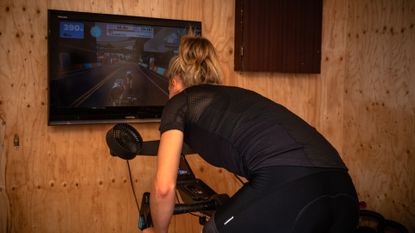
- Before you get started…
- The best indoor cycling workouts for beginners
- 1. Pyramid intervals indoor cycling workout
- 2. Sprint indoor cycling workout
- 3. Ride replacement indoor cycling workout
- 4. Threshold efforts indoor cycling workout
- 5. MAP efforts indoor cycling workout
- 6. Rev outs indoor cycling workout
- 7. Sweetspot blocks indoor cycling workout
- 8. Glycolytic Capacity Efforts indoor cycling workout
- 9. Pick ‘n’ Mix indoor cycling workout
- Tips for effective indoor cycling workouts

Turbo training sessions can provide riders with a quick and effective way to train. The lack of freewheeling means that every pedal stroke counts, there are no junctions, roundabouts or traffic to distract you from your intervals, and it doesn't ever rain indoors.
Before you get started…
Structured training (in which you work at specific intensities for specific durations) is the most effective and time efficient way to increase your fitness. Keeping a handle on the duration of your efforts is quite straightforward - any form of timer counting the minutes and seconds will do the job. Measuring the intensity, just how much effort you’re expending, is a little more complicated - and there’s a few different options.
The most basic (but most self-descriptive) is the concept of Rate of Perceived Exertion (RPE), often measured on the Borg scale of one to 10. Number one is an incredibly easy effort, three is moderate, four is ‘sort of hard’ and 10 is maximal, all-out, nothing-left-in-the-tank, nose-to-the-stem hard.
RPE can be useful, but measuring your heart rate or actual power output provides a more objective and clearly-defined guide to the level of efforts required in a session. However, before you can get started with that, you’ll first need to establish what heart rate and power numbers correlate to each level of effort for you - not everyone’s feels the same effort for the same heart rate, and there is huge variance in the power numbers that different people can sustain.
If you don’t already know your maximum or threshold heart rate - or your Functional Threshold Power (the maximum amount of power you can theoretically sustain for an hour), then do pop over to our guide cycling training zones which explains exactly the testing protocol for finding those numbers.
The best indoor cycling workouts for beginners

There are so many different things you can do on an indoor bike trainer that finding the session that best fits in with your needs and goals is important. Here's a run-down of a few of the different sessions you can do. Remember, these are suggestions and may not suit everyone perfectly.
Tailor them to suit your level of fitness. As you become used to the sessions and begin to see fitness gains, gradually increase the number of sets, and the duration of efforts for each session.
Get The Leadout Newsletter
The latest race content, interviews, features, reviews and expert buying guides, direct to your inbox!
And remember: begin any cycling workout with a 10-15 minute progressive effort with a few minutes' easy spinning. Also remember after finishing your cycling workout to spin your legs out for a good 10 minutes to make sure the muscles flushed out; this should reduce the effect of DOMS (delayed onset muscle soreness) the next day.
1. Pyramid intervals indoor cycling workout
Total time: 8min (one set)
These are 100 per cent all-out efforts followed by really steady recovery and are great to add on to the end of a session. This session, despite being short, will hurt and isn't for the faint-hearted. Give yourself at least 5min recovery between sets if you want to do more than one set.
| 15sec on | 45sec off |
| 30sec on | 30sec off |
| 45sec on | 15sec off |
| 60sec on | 60sec off |
| 45sec on | 15sec off |
| 30sec on | 30sec off |
| 15sec on | 45sec off |
2. Sprint indoor cycling workout
Total time: 35min (one set)
These are great to add on to the end of a session or as a full session as a race approaches. This session helps improve your ‘jump' - helping you get your final sprint going or getting away in a break. The long recovery ensures the energy system used is fully recovered for the next full-on sprint effort, so choose a low gear and spin your legs.
- 15sec max sprint
- 2min 45 sec spin
- Repeat 10 times per set with 5min full recovery between sets
3. Ride replacement indoor cycling workout

Total time: 2hrs 30min
Intensity should increase slightly as the efforts shorten. This can be achieved by maintaining a set cadence and then increasing resistance or using a higher gear as needed. After each effort, give yourself 5min recovery (steady spinning) in a low gear. You can shorten or lengthen efforts as suits you, or reduce percentage of MHR as needed. For this session, a quick leg-spin of 5min is all that's needed as a warm up, as it's long and the first effort isn't too hard.
| 55min effort | 65-70 per cent MHR (zone 2) |
| 40min effort | 70-75 per cent MHR (zone 2 upper) |
| 25min effort | 75-80 per cent MHR (zone 3) |
| 10min effort | 80-85 per cent MHR (zone 4) |
4. Threshold efforts indoor cycling workout
Total time: 57min
This cycling workout will make your legs ache, so ensure you have a solid warm up and cool-down. Choose a gear big enough to push, but one you are able to keep on top of and not labour, keeping a cadence of around 90-100rpm. During the recovery sections, spin your legs out in a lower gear.
| 10min effort | 75-80 per cent of MHR (zone 3) |
| 5min recovery | easy riding (zone 1/2) |
| 2 x 5min effort | 80-85 per cent of MHR (zone 4) |
| 1min recovery | between efforts (zone 1/2) |
| 5min recovery | easy riding (zone 1/2) |
| 3 x 2min efforts | 85-90 per cent of MHR (zone 4) |
| 30sec recovery | between each (zone 1/2) |
| 5min recovery | easy riding (zone 1/2) |
| 6 x 1 min efforts | 90-95 per cent of MHR (zone 5) |
| 30sec recovery | between each one (zone 1/2) |
| 5min recovery | easy riding (zone 1/2) |
5. MAP efforts indoor cycling workout
Total time: 1hr 5 mins
This MAP (Maximal Aerobic Power) efforts cycling workout stresses the aerobic system and is useful for boosting your speed on steep climbs.
MAP is defined as the maximal power efforts we can sustain predominantly aerobically. Working at this intensity not only improves your aerobic capacity, it also helps your ability to produce large amounts of power for intervals of between four to six minutes.
| 15min warm up | Row 0 - Cell 1 | Row 0 - Cell 2 |
| 4 x 4min effort | 110-120 of FTP | Row 1 - Cell 2 |
| 6min recovery | between each (zone 1/2) | Row 2 - Cell 2 |
| 10min warm down | easy riding (zone 1/2) | Row 3 - Cell 2 |
6. Rev outs indoor cycling workout
Total time: 1hr
This cycling workout targets pedalling efficiency with six 15-second efforts, where the goal is to spin your legs as fast as possible in each effort. The aim of this is to help reduce ‘muscle coactivation’, which makes it harder to spin quickly.
Muscle coactivation occurs when you push down on the pedals with your quads, yet you experience resistance from the hamstring, mainly because the hamstrings are trying to help stabilize the knee.
| 10min warm up | Row 0 - Cell 1 | Row 0 - Cell 2 |
| 6 x 15sec effort | >140 RPM | Row 1 - Cell 2 |
| 8min recovery | between each (zone 1/2) | Row 2 - Cell 2 |
| 2min warm down | easy riding (zone 1/2) | Row 3 - Cell 2 |
7. Sweetspot blocks indoor cycling workout
Total time:
Sweetspot has often been referred to as ‘the best bang for your buck’ training. It enables you to accumulate the most training stress within the shortest time sustainably. With this sweetspot blocks cycling workout, you’re really making the most of the time you spend churning away inside.
Another benefit of working at this intensity is that it is heavily reliant on fuelling with carbohydrates for a long period of time, so it can assist in improving our capacity to break down and utilise carbohydrates at a higher rate.
| 10min warm up | Row 0 - Cell 1 | Row 0 - Cell 2 |
| 2 x 15min effort | 108 of FTP | Row 1 - Cell 2 |
| 10min recovery | between each (zone 1/2) | Row 2 - Cell 2 |
8. Glycolytic Capacity Efforts indoor cycling workout
Total time:
Efforts such as those in this Glycolytic Capacity Efforts cycling workout are referred to as glycolytic efforts because of the way in which we produce power at these intensities. This happens when we break down glucose into lactate without using oxygen (anaerobically) and, although it doesn’t produce as much ATP (Adenosine Triphosphate, which our body uses as energy for every action), it produces it far more quickly than breaking down fats or carbohydrates aerobically.
| 25min warm up | Row 0 - Cell 1 | Row 0 - Cell 2 |
| 4 x 1min effort | 180 of FTP | Row 1 - Cell 2 |
| 6min recovery | between each (zone 1/2) | Row 2 - Cell 2 |
| 4min warm down | Row 3 - Cell 1 | Row 3 - Cell 2 |
9. Pick ‘n’ Mix indoor cycling workout
Total time:
Looking for a mix of efforts to keep your training interesting? This Pick ‘n’ Mix cycling workout is designed to help with multiple fitness targets, such as repeated effort capacity, recovery at higher intensities and improving VO2max.
| 15min warm up | Row 0 - Cell 1 | Row 0 - Cell 2 |
| 10 x 30sec effort | 150 of FTP | Row 1 - Cell 2 |
| 30sec recovery | between each (zone 1/2) | Row 2 - Cell 2 |
| 5min recovery | easy riding (zone 1/2) | Row 3 - Cell 2 |
| 3 x 1min effort | 138 of FTP | Row 4 - Cell 2 |
| 3 x 3min | between each 108 of FTP | Row 5 - Cell 2 |
| 5min recovery | easy riding (zone 1/2) | Row 6 - Cell 2 |
| 4min effort | 138 of FTP | Row 7 - Cell 2 |
| 10min warm down | Row 8 - Cell 1 | Row 8 - Cell 2 |
Tips for effective indoor cycling workouts
Many riders have a love/hate relationship with turbos. Some use them only when they absolutely have to, while others use them all year round. However you feel about yours, you can't deny the performance improvements they offer - if used effectively.
The reason many dislike the indoor trainer is because sessions are hard and relentless. Constant resistance on the back wheel means there is often no respite or room for a cheeky freewheeling rest. But, for the same reason, indoor cycling has a big impact on your riding, leading to large fitness improvements.
Here are some tips to help you enjoy and get the most out of indoor cycling workouts:
1. Indoor cycling workouts much be specific
One of the main benefits of indoor cycling is that every session can be tailored to meet your individual requirements. With the numerous technological improvements in measuring output, indoor cycling workouts can now be suited to any ability.
Using power or heart rate to measure intensity is very useful for indoor sessions. Once you've found your maximum, working to a predetermined percentage of this maximum is an effective way to work specific metabolic systems, thus stimulating improvements. This also means sessions are conducted at the correct intensity for each individual.
Combining these pre-determined physiological thresholds with other output measures such as cadence or speed make workouts even more specific. Leg-speed, strength and other areas can be worked on, depending what needs improving.
The use of different measures also allows riders to focus on sessions, giving something to aim at and keep you going through harder efforts. Once maximum heart rate has been found and intensities have been calculated, stick with them. If you push too hard, you'll suffer and ‘blow' before the end; too easy and you won't reap the rewards.
2. Vary your indoor cycling workouts
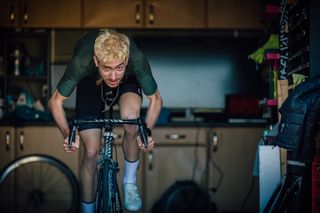
The different options on an indoor trainer are endless. You can put a film or a stage of the Tour de France and ride like you're out on a Sunday group ride, or focus on a specific weakness. Then again, you might just want to bash out a 30-minute cycling workout to wind down from work. There's also a plethora of indoor training apps for cycling now to enhance your indoor experience.
Every time you climb aboard your bike indoors, there's a different session to be done. Variety relieves the monotony and boredom many associate with indoor cycling. New and adapted sessions keep your mind fresh and focused.
On the other hand, some riders like to do basically the same session each time, only lengthening efforts or shortening recovery periods slightly to gradually progress. Seeing or feeling improvements through the season is motivation enough for these creatures of habit. Again, it comes down to making training specific to your needs; you alone know what really motivates you.
3. Keep cool and hydrated during indoor cycling workouts
When you're training indoors, you don't get the benefit of the cool air rushing past your face. As a result, indoor cycling can become a hot and sweaty businesses.
Always aim to have a fan in the room (ideally pointed at you) during your sessions. Overheating can cause your heart rate to rise higher than it would naturally for the effort you're putting in - so being too hot can be confusing if you train with heart rate, and can cause fatigue to set in quickly.
You will sweat, so have water close by so you can keep hydrated.
Also, one of the most common indoor training mistakes is not protecting your bike from sweat. Place a towel over your handlebars to protect the headset from corrosion (gross, but true).
4. Longer indoor cycling workouts during the winter
Traditionally, winter is when cyclists get in their base miles, ready for the season ahead. This means lots of long, low-intensity riding. No one is able to tolerate sitting for over two hours on the turbo with no structure, no matter how much they love it.
This is where longer intervals come into play. These are done at a relatively high endurance intensity, known as ‘tempo', which is roughly 70-80 per cent of your maximum heart rate. This intensity is hard but can be maintained and causes deep breathing. The longest effort recommended at this intensity is around an hour.
Another indoor training option to consider is bike rollers. These are another great type of trainer, owing to the light resistance and the fact that a reasonable level of concentration is needed to balance and stay on. Hence, riding on rollers is more similar to being out on the road than an indoor bike trainer, and a lot more interesting.
While doing these longer sessions, try watching a bike race to keep you motivated and focused on the riding. But remember to also have a heart rate or power measurement to keep focused on maintaining the desired intensity.
These sessions are really great at improving aerobic endurance and are a great replacement for not being able to go out for your scheduled ride.
5. HIIT indoor cycling workouts during spring
Usually, top-end high-intensity sessions are left until spring - once the winter base has been put down. Many cyclists have the old-school mentality, regarding winter as just for getting in long, slow miles to improve endurance. However, recent research has shown that similar endurance improvements come from short, sharp interval sessions too.
These shorter sessions have the added benefits of being quick to do, as well as improving other metabolic systems, alongside endurance. They are also less boring. High Intensity Interval Training (HIIT) cycling workouts should not replace all your long-ride-mimicking indoor cycling sessions or long rides, but used to relieve the boredom and monotony of repeating the same session over and over. That said, nothing beats getting in the miles out on the road - a tried and tested way to succeed in cycling.
HIIT sessions usually include maximum sprint efforts of around 30 seconds in length, with around double the duration of the effort as recovery spinning.
6. Threshold focused indoor cycling workouts during spring
Similar to the high-intensity intervals, these threshold sessions are traditionally done during spring. But, again, there's no harm throwing in a couple every now and again during the winter, to keep a bit of variety in training.
Improving lactate threshold is particularly important for racing. Efforts within these cycling workouts can vary in length and slightly in intensity; for example, an intensity of 90-95 per cent of maximum heart rate could be held for three minutes, but for a 10-20-minute effort, 80-85 per cent is more realistic. Improving lactate threshold is good for climbing and for time triallists.

Thank you for reading 20 articles this month* Join now for unlimited access
Enjoy your first month for just £1 / $1 / €1
*Read 5 free articles per month without a subscription

Join now for unlimited access
Try first month for just £1 / $1 / €1

I’ve been hooked on bikes ever since the age of 12 and my first lap of the Hillingdon Cycle Circuit in the bright yellow kit of the Hillingdon Slipstreamers. For a time, my cycling life centred around racing road and track.
But that’s since broadened to include multiday two-wheeled, one-sleeping-bag adventures over whatever terrain I happen to meet - with a two-week bikepacking trip from Budapest into the mountains of Slovakia being just the latest.
I still enjoy lining up on a start line, though, racing the British Gravel Championships and finding myself on the podium at the enduro-style gravel event, Gritfest in 2022.
Height: 177cm
Weight: 60–63kg
-
 Tweets of the week: Pogačar can be beaten, Pidcock meets the royals, and Remco's an Arsenal fan
Tweets of the week: Pogačar can be beaten, Pidcock meets the royals, and Remco's an Arsenal fanSadly for Tadej Pogačar, serial winning doesn't seem to apply to go karting
By Tom Davidson Published
-
 Friday roundup: Rapha does sportswear, Oakley meets PNS and Restrap makes a vest
Friday roundup: Rapha does sportswear, Oakley meets PNS and Restrap makes a vestTwo new clothing lines, some hi-tech smart glasses and a hydration vest to inspire you to ride further
By Luke Friend Published
-
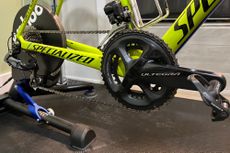 Indoor trainers damage carbon bikes, and 5 other indoor cycling lies uncovered
Indoor trainers damage carbon bikes, and 5 other indoor cycling lies uncoveredCommon cycling trainer misconceptions debunked
By Greg Kaplan Published
-
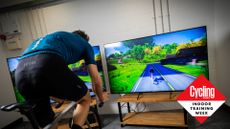 How to challenge yourself on Zwift without entering a race
How to challenge yourself on Zwift without entering a raceBuilding up to more demanding routes, setting PBs up the Alpe du Zwift, hunting out the in-game segments – there are so many ways to push yourself without taking to the virtual start-line
By Anna Marie Abram Published
-
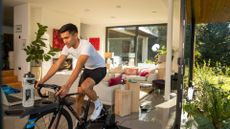 Nine things I wish I knew when I started indoor cycling...
Nine things I wish I knew when I started indoor cycling...And yes, the surprising extent to which human sweat can corrode a headset is there at number six
By Sam Gupta Published
-
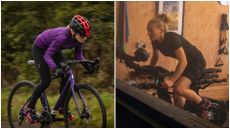 Are your indoor and outdoor rides working against each other?
Are your indoor and outdoor rides working against each other?Here’s how to successfully combine your indoor and outdoor rides for maximum fitness gains
By Deena Blacking Published
-
 Ask a coach: ‘I'm over 50, are there any indoor workouts I should avoid?’
Ask a coach: ‘I'm over 50, are there any indoor workouts I should avoid?’Here’s how you can get the most from indoor training as you get older
By Alex Welburn Published
-
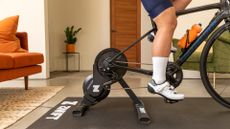 Zwift’s new Hub One smart trainer ditches the cassette for compatibility with 'almost any 8-12 speed bike'
Zwift’s new Hub One smart trainer ditches the cassette for compatibility with 'almost any 8-12 speed bike'The Hub One offers ‘virtual shifting’ similar to a smart bike - with the resistance changes handled internally, there’s no reason for more than one sprocket
By Anna Marie Abram Published
-
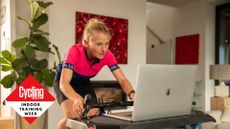 Benefits of indoor cycling - eight reasons to ride inside this fall and winter
Benefits of indoor cycling - eight reasons to ride inside this fall and winterTime efficiency, training specificity and more control over external factors are just a few, here are some others...
By Anna Marie Abram Published
-
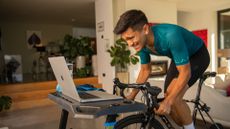 Eight of the most common indoor training mistakes and how to avoid them
Eight of the most common indoor training mistakes and how to avoid themInaccurate FTP testing, when to use ERG mode, sweat protection - we take you through the common pitfalls most of us have all hit at some point…
By Anna Marie Abram Published